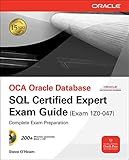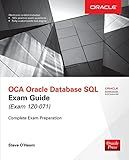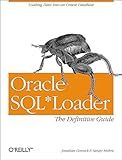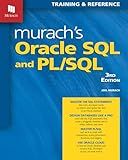Best Oracle SQL Guides to Buy in December 2025

OCE Oracle Database SQL Certified Expert Exam Guide (Exam 1Z0-047) (Oracle Press)
- MINT CONDITION GUARANTEE: PERFECT PRODUCTS EVERY TIME!
- SAME-DAY DISPATCH: QUICK DELIVERY FOR ORDERS BEFORE NOON!
- HASSLE-FREE RETURNS: SHOP RISK-FREE WITH OUR NO QUIBBLES POLICY!



OCA Oracle Database SQL Exam Guide (Exam 1Z0-071) (Oracle Press)



Oracle PL/SQL Language Pocket Reference: A Guide to Oracle's PL/SQL Language Fundamentals



Oracle SQL*Loader: The Definitive Guide
- QUALITY ASSURANCE: ALL BOOKS CHECKED FOR READABILITY AND CONDITION.
- ECO-FRIENDLY CHOICE: SAVE TREES BY BUYING PRE-OWNED BOOKS!
- AFFORDABLE PRICING: GET GREAT READS AT BUDGET-FRIENDLY PRICES.



SQL Basics: DATAMINING REFERENCE GUIDE FOR ORACLE DATABASES



Oracle SQL*Plus Pocket Reference: A Guide to SQL*Plus Syntax (Pocket Reference (O'Reilly))



Murach's Oracle SQL and PL/SQL Professional Data Analytics Guide for Database Development & Cloud Hosting - Learn Efficient Statements, Stored Procedures & Database Design (3rd Edition)


To group by one field in Oracle, you can use the SQL GROUP BY clause. This clause is used with the SELECT statement to group rows that have the same values in one or more columns. By specifying the field you want to group by in the GROUP BY clause, Oracle will group the data based on the values in that field. For example, if you have a table of sales data and you want to group the sales by the salesperson's name, you can use the following SQL query:
SELECT salesperson_name, SUM(sales_amount) FROM sales_table GROUP BY salesperson_name;
In this example, the data from the sales_table is grouped by the salesperson_name field, and the total sales_amount for each salesperson is calculated using the SUM function.
How to filter data after grouping by one field in Oracle?
To filter data after grouping by one field in Oracle, you can use the HAVING clause in your SQL query. The HAVING clause is used to restrict the groups of rows returned by a GROUP BY clause based on specified conditions.
Here's an example of how to filter data after grouping by one field in Oracle:
SELECT column_name, aggregate_function(column_name) FROM table_name GROUP BY column_name HAVING condition;
In this query:
- Replace column_name with the name of the column you want to group by and select.
- Replace aggregate_function(column_name) with the aggregate function you want to apply to the grouped data (e.g. SUM, COUNT, AVG).
- Replace table_name with the name of the table you are querying.
- Replace condition with the filtering condition you want to apply to the grouped data.
For example, if you want to filter out groups where the sum of a certain column is less than a certain value, you can write a query like this:
SELECT department_id, SUM(salary) FROM employees GROUP BY department_id HAVING SUM(salary) > 100000;
This query will return the department IDs and the total sum of salaries for each department, but only for departments where the total sum of salaries is greater than 100,000.
What is the purpose of using the GROUPING SETS clause in Oracle?
The GROUPING SETS clause in Oracle allows you to group data based on multiple criteria within a single query. This clause is used to generate multiple levels of grouping in a single query, providing a more flexible way to organize and summarize data.
By using the GROUPING SETS clause, you can specify different levels of grouping in the same query, enabling you to create multiple groups and subtotals within a single result set. This can be particularly useful when you want to generate complex reports or analyze data at different levels of granularity.
Overall, the purpose of the GROUPING SETS clause in Oracle is to provide a more efficient and concise way of performing multi-level grouping and aggregation on data within a single query.
What is the maximum number of columns that can be included in the GROUP BY clause in Oracle?
In Oracle, the maximum number of columns that can be included in the GROUP BY clause is 255.
How to handle duplicate values when grouping by one field in Oracle?
To handle duplicate values when grouping by one field in Oracle, you can use the DISTINCT keyword within your SQL query. This will ensure that only unique values are considered when grouping by the specified field.
For example, if you have a table called "employees" with a field "department" and you want to group by department but ignore any duplicate values, you can write the following SQL query:
SELECT department, COUNT(DISTINCT employee_id) as employee_count FROM employees GROUP BY department;
In this query, the COUNT(DISTINCT) function is used to count only unique employee IDs within each department, ensuring that duplicate values are not included in the count.
How to optimize queries when grouping by one field in Oracle?
To optimize queries when grouping by one field in Oracle, you can follow these best practices:
- Use Indexes: Create indexes on the columns that are being used in the group by clause. This will help Oracle quickly locate the required data and improve query performance.
- Avoid Using DISTINCT: Instead of using DISTINCT in your query, try using GROUP BY clause. DISTINCT can be costly in terms of performance as it requires sorting the data, whereas GROUP BY can utilize indexes to efficiently group the data.
- Use Aggregate Functions: Instead of fetching all data and then performing aggregation in your application code, use aggregate functions like SUM, AVG, COUNT directly in your query. This will reduce the amount of data transferred and processed by Oracle.
- Use Materialized Views: Consider creating materialized views for frequently used group by queries. Materialized views store pre-aggregated data and can significantly improve query performance.
- Optimize Joins: If your query involves joining multiple tables, ensure that you are using the appropriate join method (e.g. INNER JOIN, LEFT JOIN) and that the join conditions are optimized. Use indexes on join columns to speed up the process.
- Use WHERE Clause: Apply filters using the WHERE clause to reduce the number of rows that need to be processed for grouping. This will help Oracle quickly narrow down the data set before performing the grouping operation.
- Monitor Query Performance: Use Oracle's query execution plan and statistics tools to identify any performance bottlenecks in your query. Analyze the execution plan to see if the query is utilizing indexes and make necessary adjustments for optimization.
